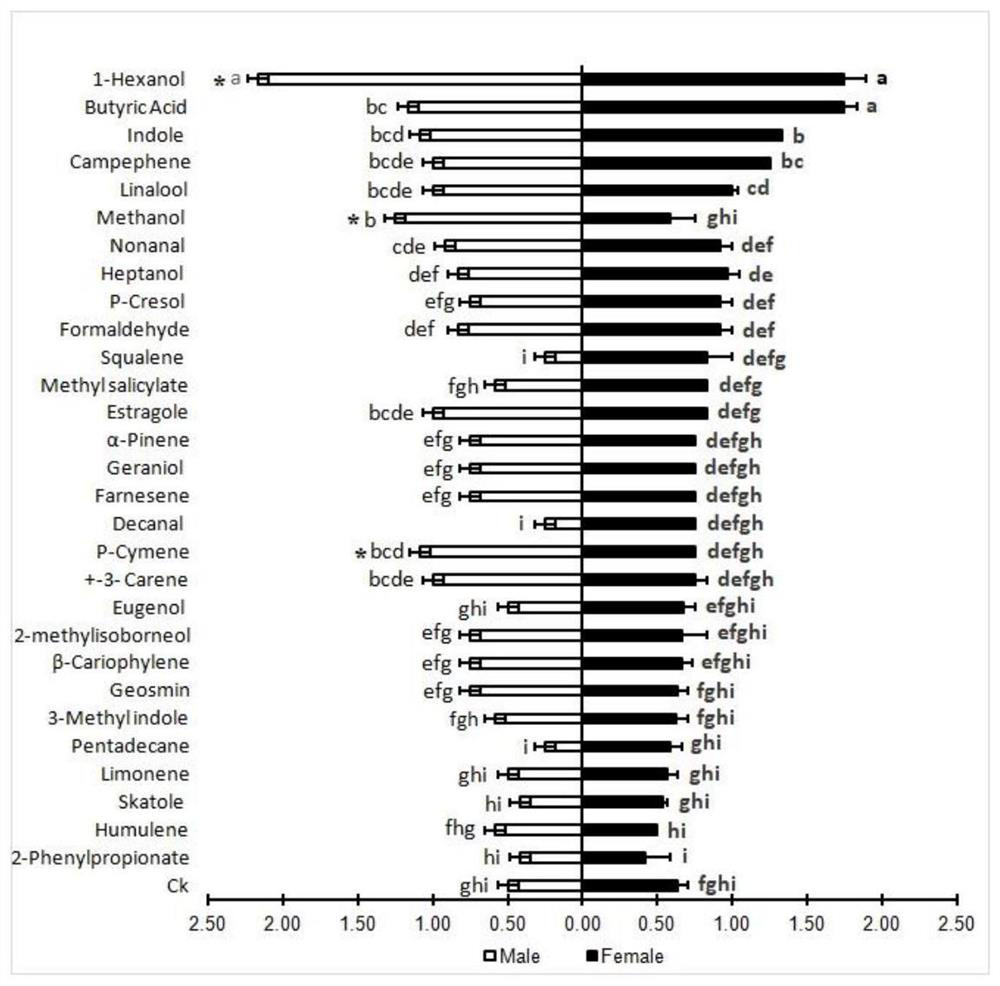A kind of cow dung source attractant for preventing and controlling adults of black gill beetle
A technology of dark gill beetle and attractant, which is applied in the direction of attracting pests, pest control, biocide, etc., can solve the problem of reducing the attractiveness of scarabs, and achieve low production cost, good control effect, and environmental friendliness
- Summary
- Abstract
- Description
- Claims
- Application Information
AI Technical Summary
Problems solved by technology
Method used
Image
Examples
Embodiment 1
[0015] The GC-MS analysis of embodiment 1 cow dung extract components
[0016] Both unripe and decomposed manure were analyzed. Gas chromatograph: Shimadzu GCMS-QP2010SE; Chromatographic column: RTx-5MS (30m×0.25mm i.d., SGE) capillary column. Heating program: initial temperature is 50°C, keep for 3min; rise to 190°C at 20°C / min, keep for 3min; rise to 280°C at 5°C / min, keep for 5min.
[0017] The GC-MS results of undecomposed and decomposed cow manure are shown in Table 1 and Table 2, respectively.
[0018] Table 1
[0019]
[0020] Table 2
[0021]
[0022] It can be seen that a total of 12 components were obtained in the undecomposed cow dung, and a total of 11 components were obtained in the decomposed cow dung.
Embodiment 2
[0023] Embodiment 2 The antennal potential response of the dark beetle to different compound monomers
[0024] A total of 28 kinds of cow dung volatiles in Example 1 and plant volatile monomers that have been proved to have an attractive effect on scarab beetles in other people's research results were tested for insect antennal potential response. Using paraffin oil as a solvent, all 28 kinds of volatile monomers were diluted into a solution to be tested with a concentration of 0.1%. Select very active black beetle adults in plastic basins, place them on filter paper, and under a dissecting microscope, cut off the antennae base quickly with a scalpel, and mix the isolated antennae base with a conductive liquid (containing 750mg / ml NaCl , 35mg / ml KCl, 29mg / ml CaCl2·2H 2 O aqueous solution) was connected to the reference electrode, and the tip of the antennae was inserted into the recording electrode. The silver-silver chloride wire is connected to the electrode and connected ...
Embodiment 3
[0027] Embodiment 3 The antennal potential response of the black beetle to different concentrations of butyric acid solutions
[0028] Using paraffin oil as solvent, butyric acid (Butyric acid) was diluted to solutions with mass fractions of 10%, 1%, 0.1%, 0.01%, and 0.001%, respectively, and each gradient solution was subjected to insect antennal potential test. The method is as in the example 2.
[0029] The result is as figure 2 shown.
[0030] It can be seen that the dark gill beetle has electrophysiological activity to various concentrations of butyric acid (Butyric acid) solutions, and the greater the concentration, the stronger the electrophysiological activity.
PUM
 Login to View More
Login to View More Abstract
Description
Claims
Application Information
 Login to View More
Login to View More - R&D
- Intellectual Property
- Life Sciences
- Materials
- Tech Scout
- Unparalleled Data Quality
- Higher Quality Content
- 60% Fewer Hallucinations
Browse by: Latest US Patents, China's latest patents, Technical Efficacy Thesaurus, Application Domain, Technology Topic, Popular Technical Reports.
© 2025 PatSnap. All rights reserved.Legal|Privacy policy|Modern Slavery Act Transparency Statement|Sitemap|About US| Contact US: help@patsnap.com



